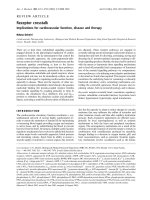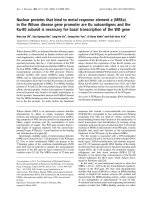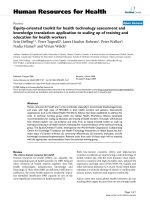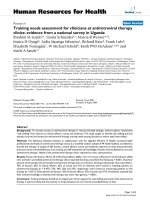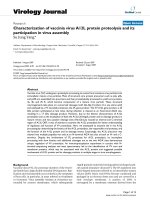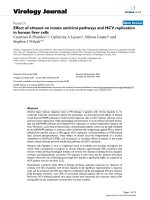Báo cáo sinh học: "AAV-mediated gene therapy for metabolic diseases: dosage and reapplication studies in the molybdenum cofactor deficiency model" pps
Bạn đang xem bản rút gọn của tài liệu. Xem và tải ngay bản đầy đủ của tài liệu tại đây (4.38 MB, 7 trang )
BioMed Central
Page 1 of 7
(page number not for citation purposes)
Genetic Vaccines and Therapy
Open Access
Short paper
AAV-mediated gene therapy for metabolic diseases: dosage and
reapplication studies in the molybdenum cofactor deficiency model
Rita Hahnewald*, Waja Wegner and Jochen Reiss
Address: Institut für Humangenetik der Universität Göttingen, Heinrich-Düker-Weg 12, 37073 Göttingen, Germany
Email: Rita Hahnewald* - ; Waja Wegner - ; Jochen Reiss -
* Corresponding author
Abstract
In a mouse model for molybdenum cofactor deficiency as an example for an inherited metabolic
disease we have determined the dosage of recombinant AAV necessary to rescue the lethal
deficiency phenotype. We demonstrated long-term expression of different expression cassettes
delivered in a chimeric AAV capsid of serotype 1/2 and compared different routes of application.
We then studied the effect of double and triple injections at different time points after birth and
found a short neonatal window for non-response of the immune system. Exposition with rAAV
capsids within this window allows transgene expression after a second rAAV transduction later.
However, exposition within this window does not trigger immunotolerance to the viral capsid,
which limits rAAV-mediated refurbishment of the transgene to only one more application outside
this permissive window.
Findings
In mammals, molybdenum cofactor (MoCo) is essential
for the activity of sulfite oxidase, xanthine dehydrogenase
and aldehyde oxidase [1]. The gene products of the
human genes MOCS1, MOCS2, MOCS3 and GEPH are
required for the biosynthesis of MoCo [2]. A mutational
block of these genes leads to MoCo deficiency (OMIM
#252150) associated with a progressive neuronal damage
and death before adolescence in affected patients. The
majority of patients suffer from type A deficiency and har-
bour mutations in the gene MOCS1 [3].Mocs1 knockout-
mice show no detectable residual Mocs1 mRNA levels and
display a severe phenotype reflecting the biochemical
characteristics of human MoCo-deficient patients [4].
Recently, we described the phenotypical rescue of Mocs1-
deficient mice by intrahepatic injection of a recombinant
adeno-associated virus (rAAV) vector carrying an expres-
sion cassette for the human MOCS1 cDNA [5]. The
MOCS1 expression cassette has been describe before and
essentially contains a hybrid promoter consisting of a
cytomegalovirus (CMV) enhancer, a human β-actin pro-
moter, exons 1 through 10 of the human MOCS1 gene, a
deleted intron 9, which allows for alternative splicing
leading to the gene products MOCS1A and MOCS1B and
a bovine growth hormone (BGH) polyadenylation (poly
A)-signal. MOCS1A and MOCS1B together produce the
relatively stable intermediate cPMP, which is further proc-
essed to active MoCo by the products of the genes
MOCS2, MOCS3 and GEPH.
Transfer of the MOCS1 gene was primarily aimed at trans-
duction of hepatocytes, since the liver is the primary organ
involved in detoxification of sulfite to sulphate by sulfite
oxidase [6]. In the meantime, mice rescued by the intrahe-
patic rAAV-MOCS1 reached a lifespan of up to 666 days.
Published: 18 June 2009
Genetic Vaccines and Therapy 2009, 7:9 doi:10.1186/1479-0556-7-9
Received: 20 March 2009
Accepted: 18 June 2009
This article is available from: />© 2009 Hahnewald et al; licensee BioMed Central Ltd.
This is an Open Access article distributed under the terms of the Creative Commons Attribution License ( />),
which permits unrestricted use, distribution, and reproduction in any medium, provided the original work is properly cited.
Genetic Vaccines and Therapy 2009, 7:9 />Page 2 of 7
(page number not for citation purposes)
To study the long-term expression profile after AAV trans-
duction, we here analyzed wild-type mice, which had
received an intrahepatic injection of AAV encoding the
green fluorescent protein (AAV-EGFP) on day 6 after birth.
The EGFP expression cassette contains the coding
sequence for EGFP instead of the MOCS1 cDNA.
Recombinant viruses were generated by using a mixture of
AAV helper plasmids encoding serotype 1 and 2 in ratio of
1:1. Previous studies had demonstrated that the chimeric
AAV1/2 vector triggers a higher expression level both in
liver and in muscle as compared to serotypes 1 or 2 [7].
Figure 1 shows that the intrahepatic application using
AAV1/2 capsids leads to predominant expression in heart
and liver, where the transgene product is detectable for
more than 10 months. However, the rate of transgene
expressing cells drops down from almost 100% in liver [5]
to approximately 5%, while in the heart after 10 months
still approximately 50% of cells expressed EGFP (figure 1).
A similar expression profile has been observed in mice
carrying the EGFP expression cassette in all cells after
microinjection of fertilized oozytes and subsequent
breeding (data not shown), which indicates that not the
rate of transduction but rather persistence of expression
accounts for this organ-specific difference.
As a further approach to the treatment of patients, we
investigated the efficacy of systemic AAV delivery. Com-
parative studies 1 month after rAAV-EGFP application
showed similar tissue transduction after either intrahe-
patic or intravenous injection [5]. Using the MOCS1
expression cassette in an AAV 1/2 capsid, we here studied
the effect of systemic delivery by tail vein injections. For
this application we used mice with a minimum body
weight of around 15 g corresponding to an age of approx-
imately 40 days. Untreated Mocs1 deficient mice are una-
ble to build cPMP, the first intermediate in the MoCo
biosynthesis, and die on average 7.5 days after birth [4].
We pretreated Mocs1-deficient mice until day 40 with peri-
odic intrahepatic injections of purified cPMP from
Escherichia coli [8] to achieve a suitable size for tail vein
injection.
Intrahepatic injections were done every other day with
increasing amounts from 2 μg in the first week up to 32 μg
from the 5th week onward. On day 40, they received 4 ×
10
9
tu AAV-MOCS1 by a single intravenous injection (n =
5). Control animals (n = 10) received the rAAV vector, in
which the MOCS1 cDNA was replaced by the fluorescent
reporter EGFP cDNA. These controls died on average 11
days after the final cPMP injection. In contrast, none of
the mice treated with AAV-MOCS1 died from MoCo defi-
ciency. Two of them have reached a life span of approxi-
mately 500 days without cPMP supplementation (figure
2, blue line). The other three mice were sacrificed in the
course of reapplication studies (see below).
Considering the lower dosage of 4 × 10
9
tu AAV-MOCS1
for systemic delivery, as compared to 1 × 10
10
tu for the
intrahepatic injections described previously [5] and
above, the results described here indicate a similar efficacy
for both application schemes. All five above described
mice had been mated and were fertile. The offspring (n =
64) died on average on day 5.35 after birth, which corre-
sponds to the lifespan of untreated homozygous Mocs1
knockout mice from matings of heterozygous mice. This
is indirect evidence that the intravenous tail vein injec-
tions did not result in germ line transmission of the vector
genome.
To estimate the necessary dosage for the treatment of
humans, we determined the minimal dosage required to
rescue the deficiency phenotype via the intravenous route.
20 neonatal Mocs1-deficient mice were pretreated with
purified cPMP as described above. At day 40 after birth,
the animals obtained a single intravenous tail vein injec-
tion containing various amounts of AAV-MOCS1 in phos-
phate-buffered saline. First, we investigated the effect of a
thirty-fold reduced dosage of AAV-MOCS1 as compared to
the experiments described above, i.e. 1.5 × 10
8
tu (n = 8).
Mice of this group died on average 28.75 ± 6.5 days after
the AAV-MOCS1 injection and discontinuation of cPMP
substitution (figure 2, red line). This reduced dosage
apparently is not sufficient to rescue the lethal phenotype.
Next, we studied the effect of an intermediate dosage of 4
× 10
8
tu AAV-MOCS1 on day 40 after cPMP pre-treatment
(n = 12). The mice of this group died on average 238.5 ±
124.4 days after AAV-MOCS1 injection and cPMP with-
drawal at day 40 after birth (figure 2, green line). All ani-
mals of this group were mated and all but one were fertile.
Again, the offspring died within the range of untreated
animals (data not shown). The observed high variance of
the life span suggests that the intermediate dosage of 4 ×
10
8
tu AAV-MOCS1 represents a borderline result and
indicates a range for the minimal dosage required for
abolishing the MoCo deficiency phenotype. With a maxi-
mum body weight of 40 g for the mice used here this
would correspond to 1 × 10
10
tu per kg body weight. A one
year old child with a body weight of 10 kg thus would
require 1 × 10
11
tu of AAV-MOCS1, which is within the
range of GMP production facilities.
Although one single injection could abolished the pheno-
type of the MoCo-deficiency, our murine model allows a
prediction only for the natural life span of mice, i.e. 2 to 3
years. In contrast to long-lasting expression in mice, rats,
hemophilic dogs and nonhuman primates, expression at
therapeutic levels in humans was limited to a period of
Genetic Vaccines and Therapy 2009, 7:9 />Page 3 of 7
(page number not for citation purposes)
Long-term expression after AAV1/2 transductionFigure 1
Long-term expression after AAV1/2 transduction. Wild-type mice obtained a single intrahepatic AAV-EGFP injection
containing 4.5 × 10
9
tu on day 6. After 10.5 months the mice were perfused with 4% paraformaldehyde. Tissue for expression
analysis was cryoprotected in sucrose and stored frozen at -80° until analysis. Cryostat sections of 3 μm thickness were pre-
pared for EGFP expression analysis. Pictures were recorded by Fluorescent microscope BX60 from Olympus. Fluorescence is
shown as an overlay of EGFP (green) and nuclear DAPI (blue) fluorescence. The images were recorded with an exposure time
of 50 ms for DAPI and 500 ms for EGFP (1 s for negative expression).
Genetic Vaccines and Therapy 2009, 7:9 />Page 4 of 7
(page number not for citation purposes)
around 8 weeks [9-14]. This difference was mainly attrib-
uted to prior infection of the human patients with natural
AAVs in combination with helper adenovirus [15]. This
leads to formation of memory CD8
+
T cells and their acti-
vation upon reexposure to the AAV capsid.
Thus, the possibility of repeated vector administrations in
the treatment of patients from an immunological point of
view is an important issue to be addressed. To this end, we
investigated the feasibility of successful rAAV re-adminis-
tration at different time points in the MoCo deficient
mouse model and compared the reapplication possibili-
ties in different developmental stages. AAV serotype 1/2
(in a 50:50 ratio) was used throughout.
In the first experiment, two Mocs1-deficient mice were pre-
treated for 40 days after birth with purified cPMP as
described above. At day 40, the two animals obtained a
single intravenous tail vein injection of 65 μl containing 4
× 10
9
tu AAV-MOCS1. The successful transduction of this
first injection was confirmed by the prolonged lifespan of
the otherwise MoCo-deficient animals. The mice were
injected for the second time after three months with an
AAV vector carrying a reporter gene vector (4 × 10
9
tu
AAV1/2-EGFP). As a positive control for the second injec-
tion, two wild-type mice obtained only 4 × 10
9
tu AAV1/
2-EGFP. The negative controls were two wild-mice with-
out any treatment. Two months after AAV1/2-EGFP injec-
tions, all six mice were perfused with paraformaldehyde.
The second AAV injection did not result in any observable
expression of EGFP in the liver (figure 3).
Studies on hemophilia B mice showed that in utero or neo-
natally AAV-treated mice do not develop antibodies to the
AAV capsid after the first injection [16]. They demon-
strated that it is possible to establish tolerance to the trans-
gene product human factor IX by these early injections
and to obtain long-term therapeutic levels in immuno-
competent mice. Here, the transgene products of the
MOCS1 expression cassette are localized intracellular and
thus not accessible for antibodies. We therefore concen-
trated on the existence of a "window of opportunity" to
induce tolerance against the viral capsid in repeated expo-
sures.
De-escalations studies of AAV1/2-MOCS1 deliveryFigure 2
De-escalations studies of AAV1/2-MOCS1 delivery. Survival of Mocs1-deficient mice injected i.v. on day 40 after birth
with various amounts of AAV-MOCS1. Group A (blue) was injected with 4 × 10
9
tu (n = 2). Group B (red) received 1.5 × 10
8
tu AAV-MOCS1 (n = 8). Group C (green) received a single injection containing 4 × 10
8
tu (n = 12).
Genetic Vaccines and Therapy 2009, 7:9 />Page 5 of 7
(page number not for citation purposes)
Three groups of two Mocs1-deficient mice each received an
intrahepatic injection of 50 μl containing 1 × 10
9
tu AAV-
MOCS1 on day 1, day 10 or day 20, respectively. The mice
were injected for the second time three months after the
first injection with 50 μl containing 1 × 10
9
tu AAV-EGFP.
Two wild-type mice served as negative controls and
obtained no second injection. Additionally, for each time
point two wild-type mice served as positive control for the
AAV-EGFP injections and obtained only the second injec-
tion with 1 × 10
9
tu AAV-EGFP. Two months after the
AAV-EGFP injections, all mice were perfused with 4%
paraformaldehyde. The groups with the first injection at
day 10 or day 20 the second injection of AAV-EGFP did
not result in any observable expression of EGFP in the
liver (figure 4a, b). In the group injected first at day 1 after
birth, both mice showed strong EGFP-expression (figure
4c), which confirms that the immune system shortly after
birth does not react to the vector capsid.
Since the products of the MOCS1 and the EGFP expres-
sion cassette do not share cross-reacting epitopes, we
could investigate the potential of early injections to
induce an immune tolerance against the viral capsid by
triple injections. Two wild-type mice obtained a first int-
rahepatic injection of 1 × 10
9
tu AAV-MOCS1 on day 1
after birth and a second injection with 1 × 10
9
tu AAV-
MOCS1 on day 10. After two months they received a third
injection of 1 × 10
9
tu AAV-EGFP. A positive control for
the AAV-EGFP injections obtained only a single injection
of 1 × 10
9
tu AAV-EGFP. Two months after AAV-EGFP
injections, all mice were perfused with 4% paraformalde-
hyde. Here, the rAAV-EGFP injections did not lead to an
EGFP expression (figure 4d), even though the first expo-
sure to AAV1/2 capsid occurred on day 1 after birth (com-
pare figure 4c). While the role of a cytotoxic T-cell
response in mice remains unclear, the immune system
clearly built neutralizing antibodies (nABs) [17,18]
against the viral vector after the second injection of viral
vector. Thus, the early exposure of the immune system to
viral vector capsid allows a successful second application
but does not induce an immunotolerance against the cap-
sid proteins.
An important factor in nAB response is the time point of
viral vector administration. The group of Petry et al [19].
showed that the efficacy of readministration is dependent
on the titer of nAB and that the level of nABs is propor-
tional to the virus dose used for the first injection. Since
repeated AAV treatment in adolescence leads to immune
responses, future experiments will have to show whether
the combination of early first exposure, a lower dosage of
virus and/or temporary immunosuppression (e.g. with
cyclosporine) facilitates more successful rAAV reapplica-
tions.
Competing interests
The authors declare that they have no competing interests.
Authors' contributions
RH participated in the design of the study, carried out the
practical work and drafted the manuscript. WW partici-
pated in the practical work and discussions. JR designed
this study and edited the manuscript. All authors read and
approved the final manuscript.
Vector reapplication in adolescenceFigure 3
Vector reapplication in adolescence. Liver sections of adult mice after different treatment schemes. Exposure times (exp.)
for EGFP are indicated (for further details see figure 1). A) First injection i.v. on day 40 with AAV-MOCS1, second injection int-
rahepatic with AAV-EGFP after 3 months. B) Only one intrahepatic AAV-EGFP injection 4 months after birth. C) No injection.
Genetic Vaccines and Therapy 2009, 7:9 />Page 6 of 7
(page number not for citation purposes)
Reapplication at different developmental stagesFigure 4
Reapplication at different developmental stages. EGFP expression two months after AAV-EGFP injection (filled triangles)
following AAV expositions (open triangles) at different developmental stages. Animals received intrahepatic AAV-MOCS1 injec-
tions as indicated on top of the lines and an intrahepatic AAV-EGFP injection 2 months after the last AAV-MOCS1 injection.
Liver sections of 2 animals are shown for each time point. Positive control animals (+) received only an AAV-EGFP injection.
Negative controls (-) received no AAV. Further details are describe in figure 1.
Publish with BioMed Central and every
scientist can read your work free of charge
"BioMed Central will be the most significant development for
disseminating the results of biomedical research in our lifetime."
Sir Paul Nurse, Cancer Research UK
Your research papers will be:
available free of charge to the entire biomedical community
peer reviewed and published immediately upon acceptance
cited in PubMed and archived on PubMed Central
yours — you keep the copyright
Submit your manuscript here:
/>BioMedcentral
Genetic Vaccines and Therapy 2009, 7:9 />Page 7 of 7
(page number not for citation purposes)
Acknowledgements
We thank Günter Schwarz (Köln) for providing cPMP and Sebastian Kügler
(Göttingen) for rAAVs. This work was supported by the Deutsche Forsc-
hungsgemeinschaft (RE 768/12).
References
1. Schwarz G, Mendel RR: Molybdenum cofactor biosynthesis and
molybdenum enzymes. Annu Rev Plant Biol 2006, 57:623-647.
2. Reiss J: Genetics of molybdenum cofactor deficiency. Hum
Genet 2000, 106(2):157-163.
3. Reiss J, Johnson JL: Mutations in the molybdenum cofactor bio-
synthetic genes MOCS1, MOCS2, and GEPH. Hum Mutat
2003, 21(6):569-576.
4. Lee HJ, Adham IM, Schwarz G, Kneussel M, Sass JO, Engel W, Reiss J:
Molybdenum cofactor-deficient mice resemble the pheno-
type of human patients. Hum Mol Genet 2002, 11(26):3309-3317.
5. Kugler S, Hahnewald R, Garrido M, Reiss J: Long-term rescue of a
lethal inherited disease by adeno-associated virus-mediated
gene transfer in a mouse model of molybdenum-cofactor
deficiency. Am J Hum Genet 2007, 80(2):291-297.
6. Garrett RM, Bellissimo DB, Rajagopalan KV: Molecular cloning of
human liver sulfite oxidase. Biochim Biophys Acta 1995, 1262(2–
3):147-149.
7. Hauck B, Chen L, Xiao W: Generation and Characterisation of
Chimeric Recombinant AAV Vectors. Mol Ther 2003,
7(3):419-425.
8. Schwarz G, Santamaria-Araujo JA, Wolf S, Lee HJ, Adham IM, Grone
HJ, Schwegler H, Sass JO, Otte T, Hanzelmann P, Mendel RR, Engel
W, Reiss J: Rescue of lethal molybdenum cofactor deficiency
by a biosynthetic precursor from Escherichia coli. Hum Mol
Genet 2004, 13(12):1249-1255.
9. Snyder RO, Miao C, Meuse L, Tubb J, Donahue BA, Lin HF, Stafford
DW, Patel S, Thompson AR, Nichols T, Read MS, Bellinger DA,
Brinkhous KM, Kay MA: Correction of hemophilia B in canine
and murine models using recombinant adeno-associated
viral vectors. Nat Med 1999, 5(1):64-70.
10. Manno CS, Pierce G, Arruda VR, Glader B, Ragni M, Rasko JJ, Ozelo
M, Hoots K, Blatt P, Konkle B, Dake M, Kaye R, Razavi M, Zajko A,
Zehnder J, Rustagi PK, Nakai H, Chew A, Leonard D, Wright JF, Les-
sard RR, Sommer JM, Tigges M, Sabatino D, Luk A, Jiang H, Mingozzi
F, Couto L, Ertl HC, High KA, Kay MA: Successful transduction of
liver in hemophilia by AAV-Factor IX and limitations
imposed by the host immune response.
nature medicine 2006,
12(3):342-347.
11. Niemeyer GP, Herzog RW, Mount J, Arruda VR, Tillson DM, Hath-
cock J, van Ginkel FW, High KA, Lothrop CDJ: Long-term correc-
tion of inhibitor-prone hemophilia B dogs treated with liver-
directed AAV2-mediated factor IX gene therapy. blood 2009,
113:797-806.
12. Mount JD, Herzog RW, Tillson DM, Goodman SA, Robinson N,
McCleland ML, Bellinger D, Nichols TC, Arruda VR, Lothrop CD Jr,
High KA: Sustained phenotypic correction of hemophilia B
dogs with a factor IX null mutation by liver-directed gene
therapy. Blood 2002, 99(8):2670-2676.
13. Nathwani AC, Davidoff AM, Hanawa H, Hu Y, Hoffer FA, Nikanorov
A, Slaughter C, Ng CY, Zhou J, Lozier JN, Mandrell TD, Vanin EF,
Nienhuis AW: Sustained high-level expression of human factor
IX (hFIX) after liver-targeted delivery of recombinant
adeno-associated virus encoding the hFIX gene in rhesus
macaques. Blood 2002, 100(5):1662-1669.
14. Wang L, Calcedo R, Nichols TC, Bellinger DA, Dillow A, Verma IM,
Wilson JM: Sustained correction of disease in naive and AAV2-
pretreated hemophilia B dogs: AAV2/8-mediated, liver-
directed gene therapy. Blood 2005, 105(8):3079-3086.
15. Mingozzi F, Maus MV, Hui DJ, Sabatino DE, Murphy SL, Rasko JJE,
Ragni M, Manno CS, Sommer JM, Jiang H, Pierce GF, Ertl HC, High
KA: CD8+ T-cell responses to adeno-associated virus capsid
in humans. nature medicine 2007, 13(4):419-422.
16. Sabatino DE, Mackenzie TC, Peranteau W, Edmonson S, Campagnoli
C, Liu YL, Flake AW, High KA: Persistent expression of hF.IX
After tolerance induction by in utero or neonatal adminis-
tration of AAV-1-F.IX in hemophilia B mice. Mol Ther 2007,
15(9):1677-1685.
17. Mingozzi F, High KA: Immune responses to AAV in clinical tri-
als. Curr Gene Ther 2007, 7(5):316-324.
18. Ponder KP, Wang B, Wang P, Ma X, Herati R, Wang B, Cullen K,
O'Donnell P, Ellinwood NM, Traas A, Primeau TM, Haskins ME:
Mucopolysaccharidosis I cats mount a cytotoxic T lym-
phocyte response after neonatal gene therapy that can be
blocked with CTLA4-Ig. Mol Ther 2006, 14(1):5-13.
19. Petry H, Brooks A, Orme A, Wang P, Liu P, Xie J, Kretschmer P, Qian
HS, Hermiston TW, Harkins RN: Effect of viral dose on neutral-
izing antibody response and transgene expression after
AAV1 vector re-administration in mice. Gene Ther 2008,
15(1):54-60.
